Field Trip: One Wall Street
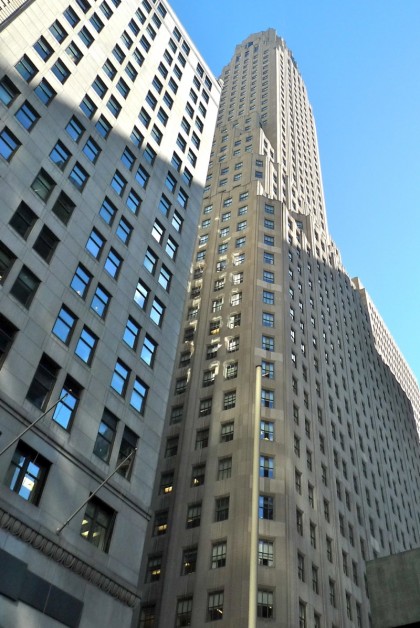 After signing up for the Historic District Council‘s Grand Central Terminal tour, I saw that the organization was leading a tour of One Wall Street. Back in the spring of 2011, after exploring the Museum of American Finance, my friend Lisa and I had noticed the lobby ceiling on the Wall Street side of the building. We tingled.
After signing up for the Historic District Council‘s Grand Central Terminal tour, I saw that the organization was leading a tour of One Wall Street. Back in the spring of 2011, after exploring the Museum of American Finance, my friend Lisa and I had noticed the lobby ceiling on the Wall Street side of the building. We tingled.
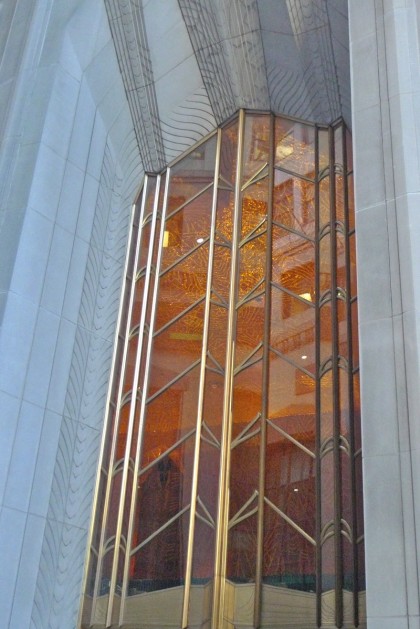 We asked the security guard if we could see more, and he said no. Ever since, I have longed to get inside. So the HDC’s $125 price tag seemed reasonable. I invited Lisa to join me, and yesterday, we set off.
We asked the security guard if we could see more, and he said no. Ever since, I have longed to get inside. So the HDC’s $125 price tag seemed reasonable. I invited Lisa to join me, and yesterday, we set off.
The building is currently home to BNY Mellon, sometimes still known as the Bank of New York Mellon, and the group met in the 10th floor museum. By the time Lisa and I had been processed by security and escorted to the museum, we didn’t have much time to investigate the exhibits, but I’m not sure I would’ve cared much about the history of the bank(s). The company’s curator spoke about how Alexander Hamilton founded the Bank of New York in 1784, making it the oldest bank in the country; it was at 48 Wall for 200 years, until it acquired Irving Bank, which was at One Wall, designed by Ralph Walker—an architect whose work has recently been reappreciated (he also did the Western Union Building at 60 Hudson)—and completed in 1930. In 2007, the Bank of New York merged with Mellon. Lisa has been prepping for a speaking gig, so enjoyed watching the magnetic curator, but I’d be a liar if I said I wasn’t a bit bored. I want to see new places! Instead, I spent time wondering who came up with the idea of a pale orange sofa on a red rug—it was bold yet WASPy.
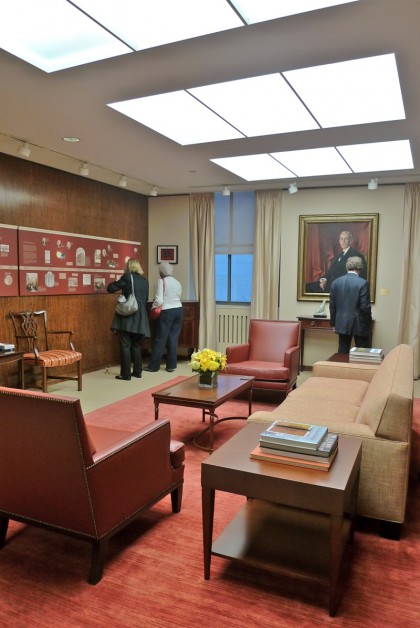 (See how the window is cut off by the dropped ceiling? We’ll come back to that.) We took the elevator back to the lobby, where we got on another elevator to the 45th floor. And then we transferred to another elevator, to get to the 49th floor. All the cramming into elevators was tedious, but at least they had Art Deco élan.
(See how the window is cut off by the dropped ceiling? We’ll come back to that.) We took the elevator back to the lobby, where we got on another elevator to the 45th floor. And then we transferred to another elevator, to get to the 49th floor. All the cramming into elevators was tedious, but at least they had Art Deco élan.
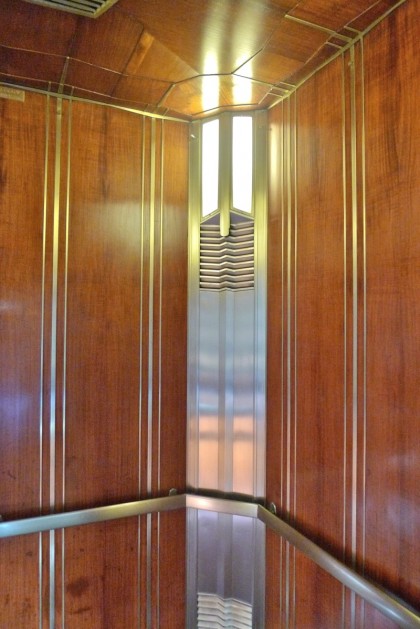 Our destination was a gorgeous, high-ceilinged meeting room. I don’t think there was much discussion about the room’s history, but I may have been too busy staring up, agog. Click on this photo:
Our destination was a gorgeous, high-ceilinged meeting room. I don’t think there was much discussion about the room’s history, but I may have been too busy staring up, agog. Click on this photo:
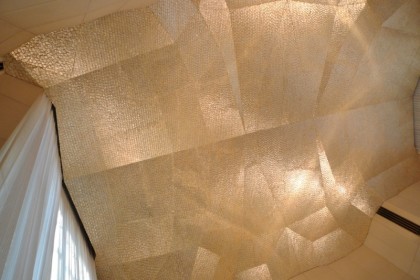 The ceiling, buckled to throw light around, had been paved with kappa seashells from the Philippines. It was extremely luxurious. Lisa wondered aloud whether she’d make it her bedroom or a receiving room.
The ceiling, buckled to throw light around, had been paved with kappa seashells from the Philippines. It was extremely luxurious. Lisa wondered aloud whether she’d make it her bedroom or a receiving room.
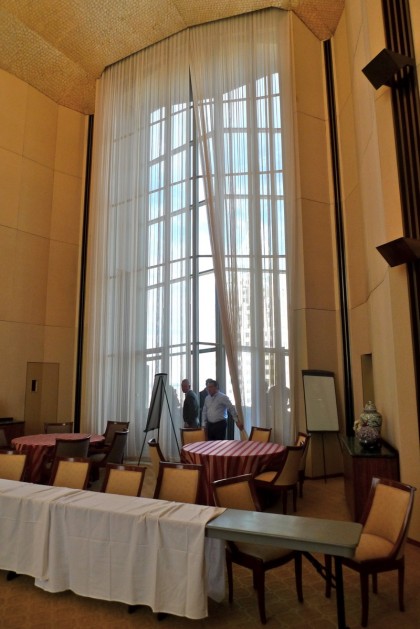 The furniture and white boards were depressing, although I did get one giggle….
The furniture and white boards were depressing, although I did get one giggle….
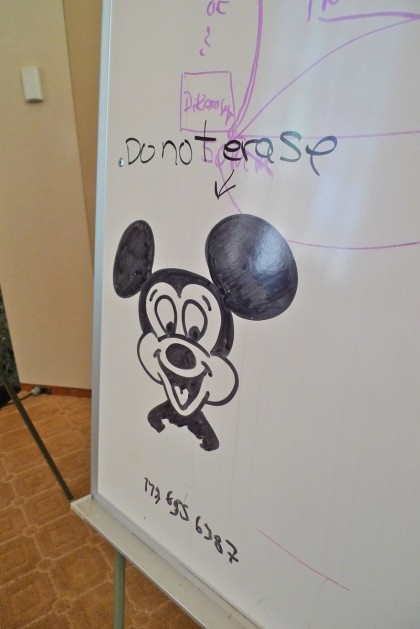 Then we all scattered fairly quickly to admire the 360-degree views. (The second image is actually from the elevator area on the 45th floor.)
Then we all scattered fairly quickly to admire the 360-degree views. (The second image is actually from the elevator area on the 45th floor.)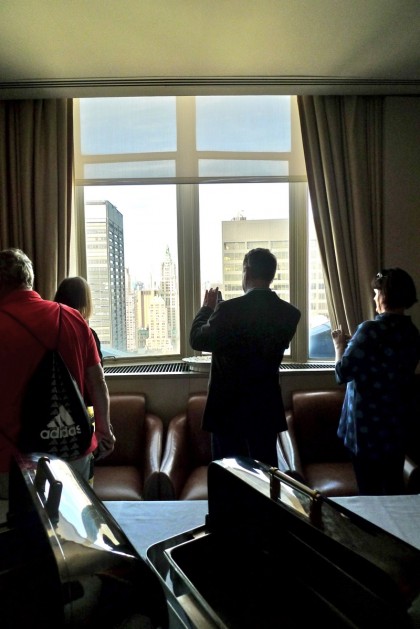
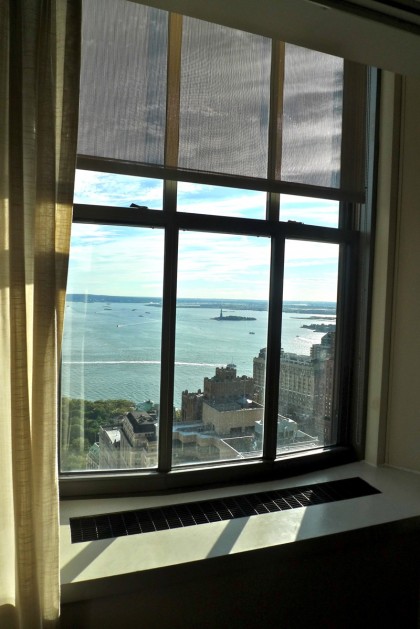 Personally, having seen rather a lot of views in these parts, I was more into the details. The coat pegs have to be original, don’t you think?
Personally, having seen rather a lot of views in these parts, I was more into the details. The coat pegs have to be original, don’t you think?
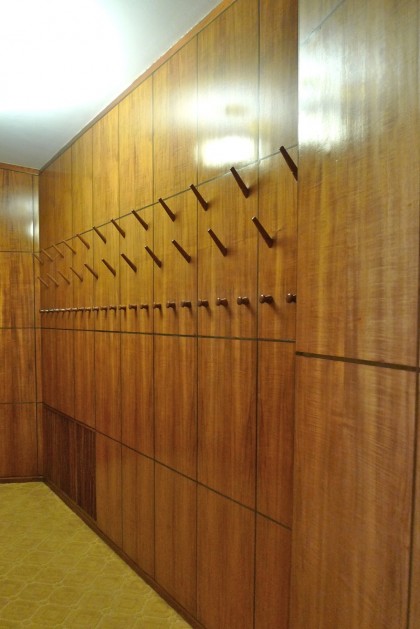
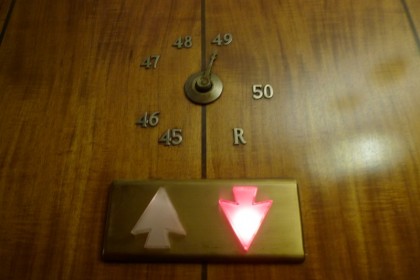
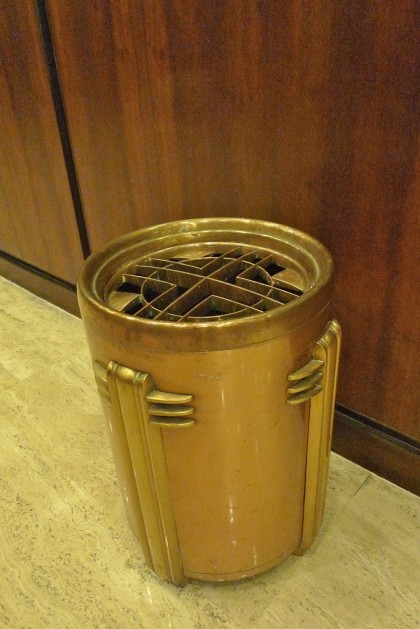
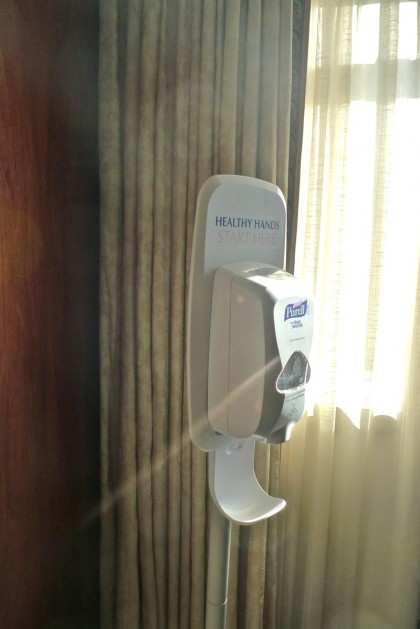 (We’ll come back to the Purell dispenser, too. But they were everywhere and I kept thinking of Lady Macbeth: Do BNY Mellon employees feel dirty?) And then it was back on the elevator to 45, and another elevator to the lobby, and over to the Red Room, as the lobby that Lisa and I had once glimpsed is known. The 8,911 square feet of mosaics were designed by Hildreth Meière. Her daughter, Louise Meière Dunn, and granddaughter Hilly Dunn, were on hand to talk about the artist.
(We’ll come back to the Purell dispenser, too. But they were everywhere and I kept thinking of Lady Macbeth: Do BNY Mellon employees feel dirty?) And then it was back on the elevator to 45, and another elevator to the lobby, and over to the Red Room, as the lobby that Lisa and I had once glimpsed is known. The 8,911 square feet of mosaics were designed by Hildreth Meière. Her daughter, Louise Meière Dunn, and granddaughter Hilly Dunn, were on hand to talk about the artist.
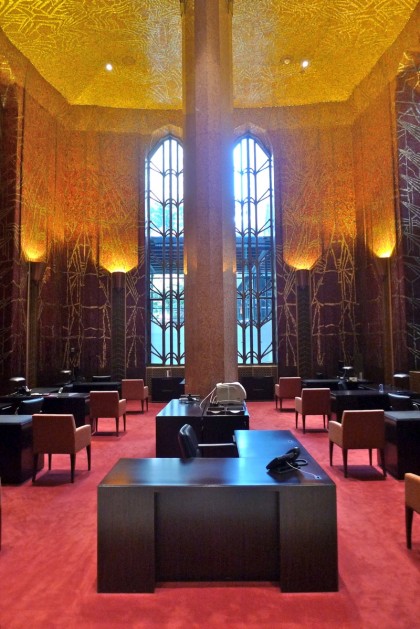
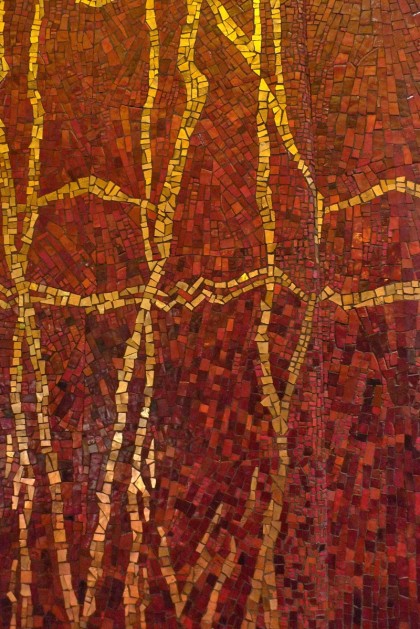
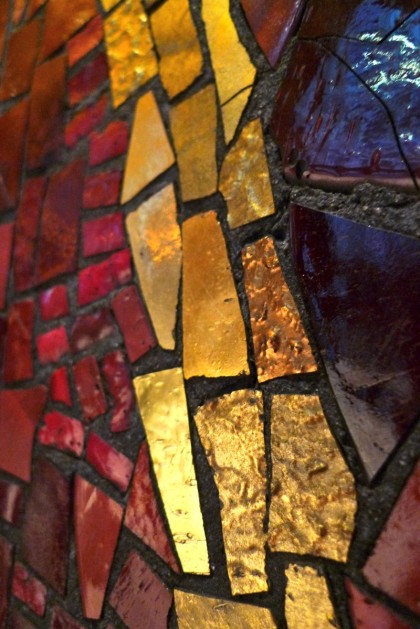 It’s an amazing room. We were given a handout that quoted a book called New York 1930: The walls are “shaded from red tiles in blue grout at the bottom to a brilliant orange in black grout on the ceiling… The graduation was so subtle that it seemed to be an effect of light rather than an actual change of color. Threaded through the pointilist field of tiles were lines of shaded gold that flashed in the light of torcheres and formed a pattern evoking a forest of bare trees or the fault lines found in minerals.” Among Meière’s many notable works were the tiled world map and the ceiling mosaic in the lobby of 32 Sixth Ave., built in 1932 for AT&T. (Which I’ve only seen once and need to see again!)
It’s an amazing room. We were given a handout that quoted a book called New York 1930: The walls are “shaded from red tiles in blue grout at the bottom to a brilliant orange in black grout on the ceiling… The graduation was so subtle that it seemed to be an effect of light rather than an actual change of color. Threaded through the pointilist field of tiles were lines of shaded gold that flashed in the light of torcheres and formed a pattern evoking a forest of bare trees or the fault lines found in minerals.” Among Meière’s many notable works were the tiled world map and the ceiling mosaic in the lobby of 32 Sixth Ave., built in 1932 for AT&T. (Which I’ve only seen once and need to see again!)
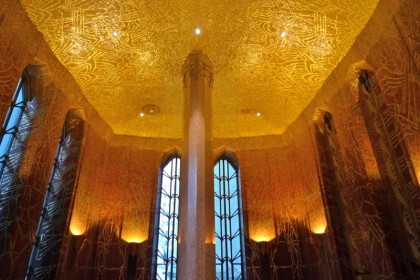 I grew fixated on the columns in the Red Room, which struck me as being of a different era—even though the tops had some tilework, they looked like they came from the Equitable Center in Midtown. The material—pink granite?—wasn’t used anywhere else in One Wall, that I saw. No one seemed to know if the columns were original, but given the inappropriate furniture everywhere—and the awkwardly dropped ceiling and Purell dispensers I mentioned above—I suspect they weren’t. Later, I went online looking for more info, and I discovered that Meière had designed a ceiling mural for the Broadway entrance. Why didn’t we get to see it?! Oh. “The ceiling in the original lobby entrance from Broadway is no longer visible. No one seems to know if this mural still exists under the new ‘dropped ceiling.'”
I grew fixated on the columns in the Red Room, which struck me as being of a different era—even though the tops had some tilework, they looked like they came from the Equitable Center in Midtown. The material—pink granite?—wasn’t used anywhere else in One Wall, that I saw. No one seemed to know if the columns were original, but given the inappropriate furniture everywhere—and the awkwardly dropped ceiling and Purell dispensers I mentioned above—I suspect they weren’t. Later, I went online looking for more info, and I discovered that Meière had designed a ceiling mural for the Broadway entrance. Why didn’t we get to see it?! Oh. “The ceiling in the original lobby entrance from Broadway is no longer visible. No one seems to know if this mural still exists under the new ‘dropped ceiling.'”
The tour was an hour, which was a blessing and a bummer. I didn’t want to stay longer, but I had hoped to see more than two rooms, a company museum, and a lot of elevators. If I think of the fee as a donation to a good cause, it burns a little less. Maybe the HDC can help BNY Mellon fund a restoration of its headquarters.
P.S. During the tour, a gentleman asked if I’d be writing about it. I assumed he only said that because I was scribbling in a notebook, so when he mentioned Tribeca Citizen I was speechless, possibly to the point of seeming rude. A reader! (Update: Two people have asked what I meant by this. I was excited to meet a reader—who had possibly taken the tour as a result of reading about it here—but by the time I realized it, it was too late to say so without being awkward.)
Previous Field Trip articles:
••• Behind the Scenes at Grand Central Terminal
••• The Howard/Crosby Microneighborhood
••• Federal Reserve Bank of New York
••• East River Ferry
••• Museum of American Finance







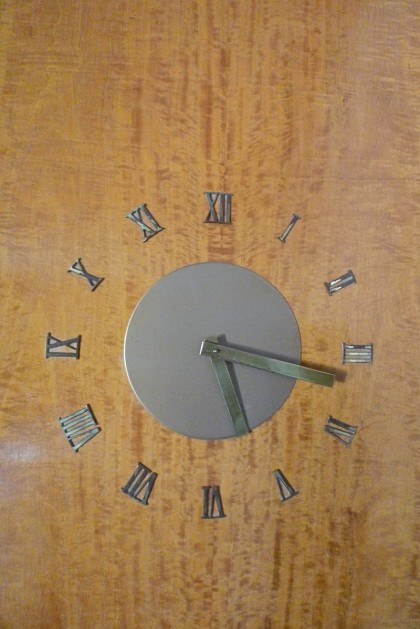







Wow! Absolutely incredible! Basically unused for the most part?
Pre-9/11 you could go into the lobby (for free!); it is one of my favorite downtown building interiors (the Cunard Building is another; what is happening with that BTW?). There is some connection to the mosaic studios in Ravenna– was it a German branch of a Ravenna company that made the tiles?
@Hudson River: The brochure we received says that Ravenna Mosaics of New York City created the mosaics, and at the tour they did say that the mosaics were fabricated in Germany. They’re made of Venetian glass.
The red room is probably my favorite space in NYC. I was fortunate to see it pre- 9/11 when I was able to just walk in off the street and stare at it while workers went on about their business. I wonder if working in such a beautiful place has a positive effect on the employees. I would have been so distracted I probably wouldn’t have got any work done at all.